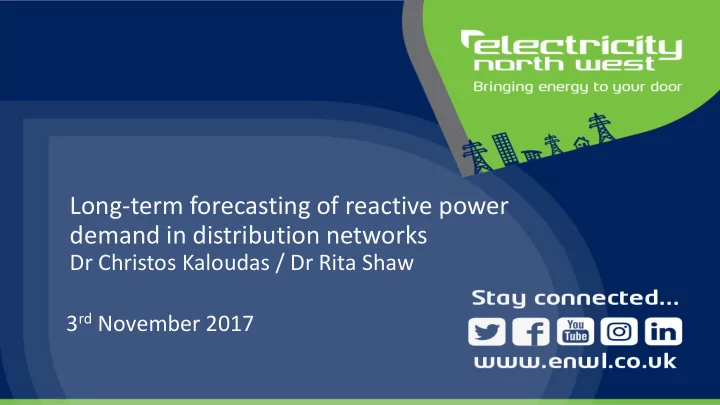

Long-term forecasting of reactive power demand in distribution networks Dr Christos Kaloudas / Dr Rita Shaw 3 rd November 2017
Introducing Electricity North West 4.9 million 2.4 million 25 terawatt hours £12 billion of network assets 56 000 km of network 96 bulk supply substations 363 primary substations 33 000 transformers
Our heritage £ 1995 2000 2010 1948 1990 2007 Electricity Privatisation: North West Water Norweb supply Sale of United Acquisition of UU business sold national-isation: Norweb plc takeover of Utilities Electricity Electricity Services: North West Norweb: United to private Electricity Board Utilities investors
RIIO regulatory framework RIIO = Total to be spent on the network £24.6 2015 - 2023 BILLION Revenue = Incentives + Innovation + Resulting annual average Outputs £10 savings in consumer bills ED1 = Electricity Distribution The power distribution 8% part of a dual fuel bill 14 DNO areas Eight years Network reliability 30% increase since 2002 Total to be spent on £1.8 the network 2015 - BILLION 2023 online available: www.ofgem.gov.uk/publications-and-updates/infographic-how-ofgems-network-price-control-proposals-riio-ed1-will-affect-you
The need for our network Views of future demand and generation affect our plans for network capacity Thermal ratings of equipment Allowed range of voltage around Fault-level ratings for network – forward and statutory limits protection reverse power flows – demand, generation, reactive Standards of security of supply including asset redundancy, Many ways to meet automation, generation contribution and demand response customers’ capacity needs
Forecasting reactive power (Q) Reactive power (Q) demand in UK Long-term forecasting of Q demand Critical at transmission-distribution Limited works (T-D) interfaces REACT project (2013-2015) Acute Q decline during minimum load First approach using network and (P) demand data ATLAS project (2015-2018) Challenges to maintain transmission Enhanced approach, more extensive voltages network modelling 6
Two related NIA projects Demand Scenarios with Electric Heat and ATLAS Commercial Capacity Options (Architecture of Tools for Load Scenarios) Winter / summer peak load Half-hourly through year Seasonal peak and minimum P and Q, then S and load factor April 2015 - October 2016 November 2015 – December 2017 7
Distribution networks in the UK 8
Monitored reactive demand Primary Substations - sum 40 GSP Inductive primaries, but capacitive GSPs (i.e., Q exports 20 to transmission) 0 Q (MVAr) -20 Interaction of demand & generation with distribution -40 networks → significant effects on Q exports -60 -80 0 500 1000 1500 2000 2500 3000 3500 4000 time (hr) 9
Proposed methodology Scenario based Time-series network Use of forecasted P modelling Effects of low carbon demand and generation technologies (LCTs), T-D interface to primary econometrics, Focus on periods of substations demographics, peak & min P demand renewables Half-hourly resolution in analyses 10
Future Q at primary substations – no network modelling • Assessment using future P at primary substations (EELG model) and trends in Q/P ratio • Q/P ratio trends • historical FY12 to 16 measured P and Q demand • seasonal trends • individual linear trends • min/mean/max daily P • future Q/P ratios • half-hourly for whole year • per GSP
Implementation of proposed methodology SCADA and metering data IPSA network model (measured P and Q) (GSP to primaries) 120 100 BSP #60 - measured demand Inputs 80 P (MW) 60 40 20 0 1 2 3 4 5 6 7 8 10 4 time (hr) - 5 years Data Processing tool (Matlab) Processes & P demand forecasting tool modelling (Excel & VBA) Time-series IPSA-Python assumptions tool network Q demand forecasting at primary substations (time-series (prototype tool under construction) power flows) modelling Modelling assumptions (e.g., load allocations, scenarios) Outputs Post-processing of time-series outputs : (Matlab – e.g., plot Q profiles, identify time windows with VAr exports) 12
Challenges to validate the Q forecasting tool 100 monitoring data time-series network modelling 50 0 Q(MVAr) -50 Critical network data: e.g. TSO controlled capacitors -100 -150 0 50 100 150 200 250 300 350 time(hr) 13
Validation of Q forecasting tool – automated processing imperfect monitoring data Data Corrections Identification of Data Problems (Half-hourly & daily analyses) 14
Future scenarios (test cases / not business as usual) 4 cases with different demand reduction at primary substations Case 1 Case 2 Case 3 Case 4 ±0% -1% -1% -1% -2% ±0% -2% -2% P P P Q P Q Q P 15
Future trends in Q exports to transmission 112 Case 1 - one GSP Case 2 - one GSP 110 Case 3 - one GSP % VAr exports to transmission Case 4 - one GSP 108 106 104 102 100 1 2 4 5 0 3 year 16
Future trends in Q exports to transmission 112 Case 1 - all GSPs Case 2 - all GSPs 110 Case 3 - all GSPs % VAr exports to transmission Case 4 - all GSPs 108 Case 1 - one GSP Case 2 - one GSP Case 3 - one GSP 106 Case 4 - one GSP 104 102 100 0 1 2 3 4 5 year 17
Duration of Q exports to transmission 60 Time-windows of Q exports identified % time exporting VArs 58 56 54 Case 1 Case 2 Case 3 Case 4 April 2016 18
Conclusions Practical benefits from time-series network modelling Transition to Proposed business as usual methodology for Time windows of using time-series long-term VAr exports to modelling of the forecasting of Q transmission whole 132 to 33kV demand using network in North Future trends in network modelling West of England individual and groups of substations 19
Thank you for your attention! christos.kaloudas@enwl.co.uk rita.shaw@enwl.co.uk 20
Recommend
More recommend